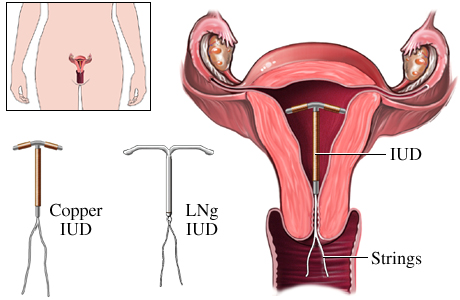 At the beginning of summer, I had a long talk with my gynecologist about my birth control options. As birth control is an empowering choice for women to control their reproductive power, the NuvaRing provided my first experience: positive and simple maintenance. It required easy self-insertion; I still had a regular menstrual cycle each month; I rarely felt the ring inside my vagina; and I never felt a sense of discomfort. As I was able to decide when and if I wanted to have a child, I experienced better intimacy, less anxiety, and a liberating sex life.
At the beginning of summer, I had a long talk with my gynecologist about my birth control options. As birth control is an empowering choice for women to control their reproductive power, the NuvaRing provided my first experience: positive and simple maintenance. It required easy self-insertion; I still had a regular menstrual cycle each month; I rarely felt the ring inside my vagina; and I never felt a sense of discomfort. As I was able to decide when and if I wanted to have a child, I experienced better intimacy, less anxiety, and a liberating sex life.
But then, I had a travel opportunity arise. I decided to move to Salvador, Brasil to pursue an artist-in-residency program to strengthen my creative focus and develop a longer piece of creative work. While I was excited career-wise, I became worried about my birth control options in Salvador. Between my insurance restrictions and the NuvaRing’s availability at local pharmacies, I wasn’t sure if my birth control purchases would be as convenient. Expressing these concerns to my doctor, I was presented with a plethora of options: get off birth control and rely solely on other protection, take the chance of finding the NuvaRing, switch to another form of birth control, or consider getting an IUD.
The truth is that IUDs continue to have a stigma. They’ve become associated with all types of infections and reproductive complications, including pelvic inflammatory disease. The first IUD was founded in the 1970s, which had a multifilament string that absorbed bacteria and provided a passageway for bacteria into the uterus. Since then, the IUD has made dramatic medical advancements, using monofilament strings and better composition materials.
While there are two types of modern IUDs that women can choose, hormonal (Mirena) or copper, I chose the Mirena, a soft, flexible IUD that releases small amounts of hormone locally into your uterus and protects you from pregnancy for up to five years. The Mirena is made of plastic with less than 1% of users developing pelvic inflammatory disease and 99% effective at preventing pregnancy. Additionally, within a year of removing it, 8 out of 10 women were able to get pregnant.
After learning all the statistics and doing the research, I still felt nervous about the IUD placement procedure. I’d have to sign a release form, come into my gynecologist’s office, and allow her to stick a long, thin device through my cervix and place the Mirena. It was like a mini surgery, anesthesia not required, but nonetheless scary. As my insurance would cover the procedure and purchase, leaving me with a $30 co-pay for the Mirena device and $15 for the procedure, I did the math and realized that five months of paying for the NuvaRing at $10 per month would amount to the same as getting the IUD inserted and having it last for five years. Five years versus five months, I decided to go with the procedure.
I laid on the exam table, legs propped up, and near delusional after taking 800 mg of ibuprofen an hour before. My gynecologist had recommended that I take two aspirin before I came, but of course, I had to be extra with my dosage to ensure the least amount of pain as possible. Funny enough, I did not feel one ounce of pain, just discomfort and a bit of nausea. I’m sure that psychologically I freaked myself out thinking about this long, thin device moving around my uterus to place the IUD. According to friends, the device going through my cervix into my uterus should’ve felt like the equivalent of childbirth. I maybe winced from the insertion because it felt awkward, but really no pain.
All in all, the procedure took approximately five minutes, and I was able to walk out of the doctor’s office without feeling a thing. The 800 mg of ibuprofen did have a wearing affect on me, as I felt extremely tired and ready for a nap. But once I slept for a few hours, I was good as new, out celebrating a friend’s birthday and drinking a glass of wine.
If you’re considering an IUD and have gotten the health clearance from your doctor, I’d say do it. I’m excited that I can travel without having to consider the location’s access to birth control, and right now, five years baby-free sounds quite appealing. Moreover, if the IUD does present any complications or issues, your healthcare provider can take it out.
Have you ever experienced an IUD placement? Or do you have an IUD and love it? Share your story.
Arielle Loren’s IUD placement was done at NYU Trinity Medical Center by Doctor Samantha Dunham.







Thanks for sharing your story. I’ve never used an IUD. I’m not sure if I would want to, but it’s good to know it’s another birth control option out there.
OMG… I wish you’d written this article a few months ago! I’ve been struggling ever since December to figure out what type of BC would be best for me. I tried the Depo Provera shot in December and had a horrible experience. I was extremely moody and had spotting literally every day for 5 months. The shot only lasts 3 months but I was still spotting even though I didn’t get another shot in March when it was due.
After that experience, I was HATING the thought of putting any hormones into my body… but I hate the thought of getting pregnant even more!! So, I started doing research and an IUD was the most attractive option. Like you said, it lasts a long time (for those of us with no baby in our 5-year plan!) and it’s relatively cheap depending on your insurance. I was also thinking of getting the arm implant. Basically, I wanted something that I could get once and then forget about until I was ready to have kids.
After looking at a lot of BC blogs online, I realized that I may have the same mood swings and spotting with any of these options b/c it could just be the way my body reacts to large doses of hormones. So instead of gamble with these things that have to be inserted, I opted to go back on “the pill.” I started last month and I haven’t had any alarming problems so far but I still get a little moody around that time of the month (which is to be expected).
Anyhoo, thanks again for the article. I hope you have a great trip and no side effects (or babies!) while you’re over there!!
@Ash: The Mirena IUD that the author describes does have hormones and lasts 5 years. But there is another type of IUD called Paraguard which uses copper to prevent pregnancy. It does NOT have hormones, and lasts up to 10 years. If you ever get tired of taking the pill, maybe you should consider Paraguard.
P.S. I also disliked the side effects of the Depo shot, and swore off any hormones. I was concerned what it effects it might have had on me in the long run. I considered the implant, but it was taken off of the market for some reason. By that time I didn’t want hormonal BC anyway.
This is a good article but there is some misinformation. One — you should not remove your IUD yourself. Let your ObGyn do it. Also in the comments–the copper IUD is hormone free and lasts for ten years. I have one and there are no hormonal side effects because…there are no hormones! There is a bit of spotting but this lightens up and dissipates over time.
@Guest: Corrected. Thank you for clearing that up 🙂
wow. i just got my copper iud put in less than a week ago and that shit was a pain i don’t even know how to describe. i thought it would be as you described, discomfort mostly. i was definitely screaming and sobbing the whole time they were inserting it, which was maybe 5 minutes or less. felt like ages. was super nauseous afterwards and had to lie there for an hour.
i mean, 5 minutes of pain is worth 10 years of childfreedom. but my experience was drastically different from yours lol.
also, they would only put mine in while on my period, don’t know if that applied to you too. and they told me to never remove it myself, but to get a doctor to do it. judging from the pain i felt when it went in, i would never try to remove that sucker on my own.
maybe it’s a difference in experiences because mine was copper? idk. just thought i’d share a diff perspective.
I have had both a Mirena (plastic, with hormones) and a Paragaurd (copper, without hormones) IUD. I love the concept.. carefree birth control for 5-10 years. I would say the insertion for both was about the same for me. Pain and cramping that lasted just a few minutes then I was able to go home. I had the Mirena first. I had if for about 8 months, had spotting on and off for the first 4 months then that resolved and I started having regular periods. However, around month 8 the IUD came out. My husband and I were being intimate and he says, “honey, something is pinching me down there”… LOL. I checked myself and sure enough the bud of the IUD was coming out!! I went to my GYN and had it taken out. He told me that he thinks that it came out because my uterus is small (I dont have any children). He reccommended that I NOT get another one because the same thing may happen. Being the stubborn person that I am, and being that he is my colleague ( I am a medical professional as well)… I insisted that I have another IUD. So he reccommended a paragaurd , which I have now. I am having a much longer period of spotting (light to medium) than I did with the Mirena, but so far no other problems. We will see if this one stays in. I will probably have it taken out in the next 2-3 years, because I do want to be a mother. Even after the problems that I have had, I still think this is a wonderful alternative to the norms of birth control that are offered up.
CRWR
I’m a Nuva ring user and interested in an IUD… Great information and comments from everyone! Thanks 🙂
I had both copper and mirena then had both removed. They were a nightmare. First go around the dr was of by a smidge and had to do it all over again. Felt like a pap smear times 10 all three times. My body couldn’t function on it heart racing,menstrual cramps I had never had before and that darn string always hung low in my low uterus so sex with my hubby was non existent for a week out of the month. Always stabbed him. Ugh ended up talking him into a vasectomy and he was more then willing after all the trouble it caused our sex life.
Never tried IUD or Mirena but I sure will in the future. Just say NO! to Depo Provera. It was very scary for me to have to wait 4 months! to have a period once we started to start a family.
It’s a pity you don’t have a donate button! I’d certainly donate to this excellent blog! I guess for now i’ll settle for book-marking and adding your RSS feed to my Google account. I look forward to brand new updates and will talk about this blog with my Facebook group. Talk soon!
Love the IUD. Had it in for 2 years. Totally fabulous. Light periods. No cramps!
Love, love, love my mirena IUD!
Had light periods at first and then they disappeared about six months in. I had a some pain during insertion, but that’s probably because I’m a little wimp. Doctor did recommend the 800 MG of Advil prior to insertion but for some reason, I forgot to take some. The sounding part of the procedure was a summabitch!!!! But it was over before I could start crying (LOL). Two years later with three left on the IUD I am certain that once its time expires, I’ll be ready for a second. I don’t want kids and my insurance won’t pay for a tubal or Essure unless I have a child first. I am keeping up with this IUD through Menopause. It is fantastic and as effective as a tubal, without the menses. LOVE!
I have the Mirena And I stopped having a monthly cycle. I still have the symptoms of a cycle but. O bleeding. Works for me!
I love my IUD. I chose the cooper IUD which lasts up to 10 years. I recommend the IUD to every woman I know. It is the most reliable form of birth control aside from abstinence and tubal ligation. It is easily reversible: with the non hormonal IUD, it is possible to get pregnant the same day you take it out. Your partner can feel secure just by feeling for the string that’s left to help you check to see if its still in place. I didn’t know that you could get the IUD without having given birth, that requirement must have changed. That’s another plus. I didn’t take any pain medication before it was inserted, but it literally felt like someone pinched my insides with a tiny little clamp. It made me flinch, but it wasn’t even enough to make me say “ouch.” From what I understand, it is the most common form of birth control among female gynos. I didn’t have health insurance so I had to pay nearly $800 for the device and procedure, but I would do it again in a heartbeat.
I haven’t gotten either, mostly because I’ve had friends who have had Mirena and had horrible experiences with it. One complained of having cramps like she was in labor for like two weeks. Another said that Mirena pierced her fallopian tubes and now she can’t have children. So it will be good ol condoms for me!